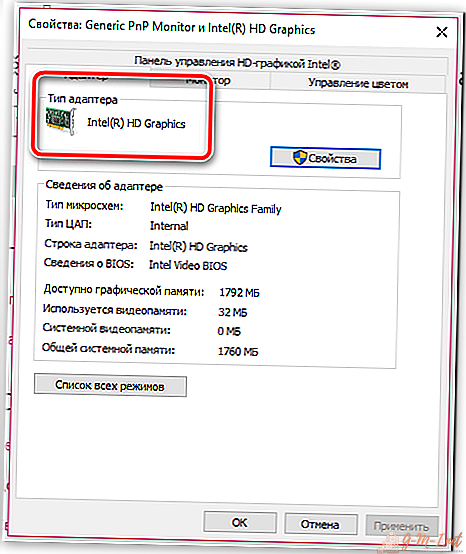 One of the internal elements of a laptop is a video card. Its main purpose is to ensure the removal of graphic information on the monitor screen. Depending on the model and quality of the installed map, the screen resolution, media file playback and picture quality will vary on different devices. If desired, you can change the internal components or improve their characteristics. But in order to do everything correctly, you need to know the type of installed elements.
One of the internal elements of a laptop is a video card. Its main purpose is to ensure the removal of graphic information on the monitor screen. Depending on the model and quality of the installed map, the screen resolution, media file playback and picture quality will vary on different devices. If desired, you can change the internal components or improve their characteristics. But in order to do everything correctly, you need to know the type of installed elements.
In order to find out the type of video card in your laptop, you can use a simple search for information in the device manager. In this case, you will not need to download additional applications and programs, all the necessary information is contained in the computer system. To learn it, use the following plan:
- Turn on the laptop to the network and run it. After that, go to the "Start" menu by pressing the corresponding key or button on the desktop of the monitor.
- Go to the control panel and select the item "System and Security" from the list provided. In the future, select the "System" section.
- From the list, select "View basic information." In this section you can find any information you need about the characteristics of the laptop.

- You can also log in quickly using the search bar in the start menu start. Enter the name "Device Manager" and the program itself will find the desired path.
- In some models, there is a call to the "Run" command with the key combination Win + R or simply Win, in the empty field of which you need to enter the desired value (in this case, "devmgmt.smc").
Important! On different versions of the path to the viewing parameters may vary. Select one of the described login options, depending on the model of equipment and installed software. So you can get basic information not only about video cards, but also about other installed components.
There is another simple method to check the information about the video card in Windows - through the properties of the screen. To do this, you need to perform the following manipulations:
- Turn on the laptop, start it and open the main window of the desktop.
- In any empty space without documents and folders, right-click to open the context menu.
- From the list of options and options that appear, select the line "Screen Resolution".
- Browse the page that opens to find the "Advanced Options", enter the appropriate section.
- Select "Graphic System Properties" and then go to the "Adapter" tab. In the menu that appears, select the line labeled "Adapter Type." Here you can find all the necessary information about the device.

This method is the fastest and most affordable.
Important! It should be borne in mind that in different operating systems, due to the changed interface, the path may slightly differ from the described variant.
If you want to know a detailed description of the parameters and technical characteristics, the above methods will not work. They contain only the name and basic description. For more complete data, you should use the installation of additional programs. You can use this option:
- Turn on the laptop, run and enter the browser.
- In the search box, type the name of the program you want to install. Follow the instructions in the dialog box that opens. The most convenient is the program GPU-Z.
- After that, go to the installed application and find the necessary information about the video card. You can also find out more about all installed boards and sensors.
Important! Download files only from official sources, and include anti-virus protection to prevent malware damage.
In addition to the methods described above, there are several other options for finding information about a video card. If the previous options did not resolve the issue, try the following methods:
- Use the special application Device ID, which is designed to recognize the installed components in the computer system.
- Run a full diagnostic via DirectX.
- Look for information on the Internet for sensors on AMD and NVIDIA chips. Find the ID to search online.
One of the above methods will help to find out which graphics card is installed in the laptop.



Leave Your Comment